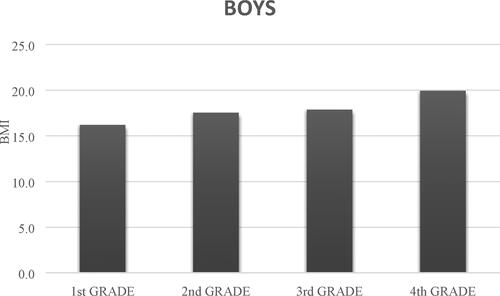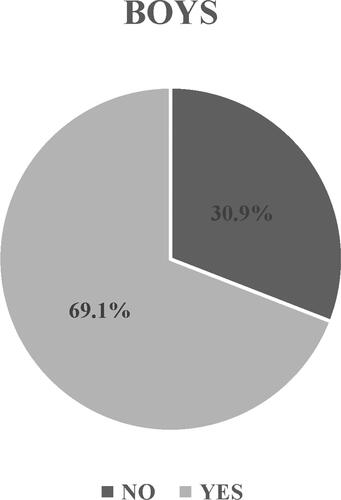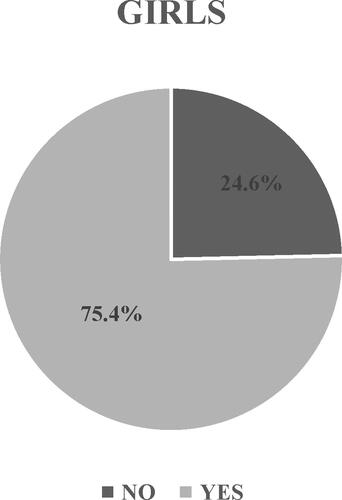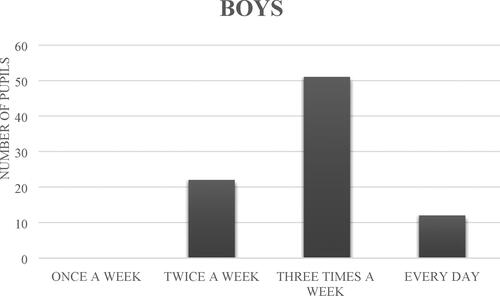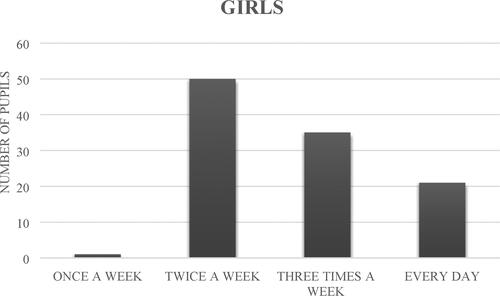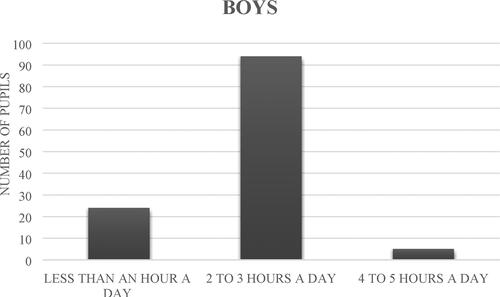Abstract
Physical inactivity is the fourth major cause of mortality in the world, so the World Health Organisation advises for children and adolescents to accumulate moderate physical activity at least 60 minutes a day with the aim to preserve health and prevent the occurrence of various chronic diseases. Elevated overweight and obesity, besides in adulthood, occur increasingly more in childhood. The aim of the research is to determine the level of nutrition and physical activity of younger school children, as well as the differences between girls and boys. The results obtained on a sample of 265 participants of a younger school age show that girls and boys have a normal nutritional level in the first and third grade, while for girls and boys of the second and fourth grade an elevated level of the body mass index (BMI) was noticed. Results show that most girls and boys of a younger school age do sports in their free time, and that they spend approximately 2 to 3 hours a day outdoors. Boys usually train three times a week, girls train two times a week, while the average boys’ training lasts 60, and the girls’ training 75 minutes.
1. Introduction
The need to propagate a healthy and active lifestyle among children is high and shows a growth trend since more and more of them are raised in a sedentary way of life. According to the World Health Organisation (WHO, Citation2010), the fourth major cause of mortality in the world is physical inactivity, and it is therefore advisable for children and adolescents (5 to 17-year-olds) to accumulate moderate physical activity at least 60 minutes a day with the aim to preserve health and prevent the occurrence of various chronic diseases. Inchley et al. (Citation2016) consider insufficient physical activity as the primary public health problem linked to childhood and adolescence. In these life periods it is extremely important to regularly engage in physical activities in terms of health and preventive effects (Mišigoj-Duraković et al., Citation2011).
Caspersen et al. (Citation1985) define physical activity as any physical movement produced by the skeletal muscle which results in the consumption of energy. Malina et al. (Citation2011) suggest that performances such as running, jumping, manifestations of muscle power and endurance, should be in the centre of children’s physical activities, wherever they are. All forms of physical exercising can bring along health benefits if practiced regularly, with a sufficient intensity and duration (WHO, 2018).
The estimation of the nutritional level regarding the body mass index is determined according to the children’s sex and chronological age based on percentile norms (Mišigoj-Duraković, Citation2008). Reliability and simplicity of use is thus ensured, and it represents a good indicator of the obesity level in childhood (Luciano et al., Citation2001). It can also be used in the estimation of malnutrition or excessive body mass and obesity during childhood and adolescence (De Onis et al., Citation2007).
In the formation of the regular physical exercising habit attention should be directed toward children and youths’ autonomous exercising in their free time. The modality, intensity and sole exercises have to be chosen by the children since they practice them individually during their free time. Physical activities, sport and sports recreation have a special importance for children and youths’ development. The earliest childhood is the right period to influence the whole children’s development, especially motor development, in a most effective way.
The increase in overweight and obesity, besides in adulthood, occurs increasingly more in childhood, so the large number of international scientists who have taken physical activity and the level of nutrition as their main research subject in the past years is not surprising (Wang & Lobstein, Citation2006). In the last few decades, world’s and domestic data have shown an evident increase in the number of overweight children and adolescents (Chen et al., Citation2006). Studies have shown that, for example, in Italy there are 36% of children aged 6 to 12 who face the problem of overweight or obesity, while Croatia takes the seventh place with this percentage being 26%. In the period from 1998 to 2012 the number of overweight or obese primary school pupils increased from 8.87% to 13.97% for boys and from 8.39% to 12.34% for girls. The causes are, as already stated, insufficient physical activity, a different type of diet and technology. The trend in the movement of central values (median) of the body mass index (BMI) in the period from 1999 to 2014 among primary and subject teaching pupils attending primary schools in Zagreb showed a mild increase in values for both sexes. Furthermore, although an increase was noticed in the observed age group, the regional analysis established that it was statistically significant only for sixth-grade (0.08 kg/m2 per year with p = 0.019) ad seventh-grade pupils (0.14 kg/m2 per year with p = 0.004) (Erdeljac et al., Citation2018). Increased body mass index multiplies the risk of certain diseases, primarily linked to diabetes type 2, hypertension, coronary artery disease and stroke, the respiratory system, cancer, reproductive functions, liver and gall-bladder diseases (Kopelman, Citation2007). Overweight and obese children aged 6 to 10 have a significantly worse motor coordination compared to their peers who belong to the group of thin or healthy weight children (Lopes et al., Citation2018). Regular physical activity, along with sport and a correct diet, play an important role in maintaining an optimal body mass, prevent obesity and the complications it brings along (Mišigoj-Duraković & Matković, Citation2007).
Research aim
The research aim was to determine the level of nutrition and physical activity of younger school children, as well as the differences among girls and boys.
Methods
2.1. Sample of participants and variables
The research was conducted via an anonymous questionnaire filled in by 1st to 4th grade children’s parents from nine primary schools of Pula. A total of 256 parents participated in the research, and they answered 13 questions relating to general data on the children (sex, age, grade, school, body height and body weight), and to children’s engagement in sports, i.e. physical activity in their free time. The body mass index (BMI) was calculated from their body height and body mass results, and it was used as an indicator of a person’s nutritional level. The body mass index (BMI) is defined as: body mass (kg)/body height2 (m2), while the calculated value for each pupil was corrected to centiles (Cole et al., Citation2000) according to children’s sex and chronological age (criteria: < 5 centiles = underweight, 5–85 centiles = healthy weight, 85–95 centiles = overweight, ≥ 95 centiles = obesity. Data for 142 girls (53.6%) and 123 boys (46.4%) were collected.
2.2. Data processing methods
The obtained data were processed by the statistical package Statistica for Windows 13, and the basic descriptive parameters were calculated: number of participants (N), arithmetic mean (AM) and standard deviation (SD). The univariate analysis of variance was used to determine the differences between girls and boys. The differences were tested at the significance level p < 0.05.
Results and discussion
The participant sample mostly consisted of pupils who turned 10 at the time of the research (27.5%), followed by 8-year-olds (25.3%) and 9-year-olds (24.9%). Pupils who turned 7 made 18.5% of the sample, while the least number of pupils were 11 years old (3.0%) and 6 years old (0.8%). In line with the data, at the time of the research most participants attended the 4th grade (28.3%), followed by 2nd graders (27.9%) and 3rd graders (24.5%). The smallest number of participants belonged to the 1st grade (19.2%) ().
Figure 1. Graphic representation of participants’ distribution according to their school grade.
Source: The authors.
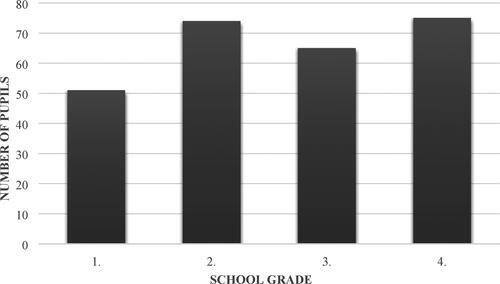
The obtained results show that 1st to 4th grade primary school boys are averagely 136.5 cm tall and they weigh 33.7 kg (). Their BMI is 17.82 which makes their nutritional status normal. The obtained average values of height and mass show that pupils included in this research are half a centimetre shorter (137.55 cm) and weigh half a kilogram more (33.18 kg) than their peers from a former Croatian study (Kunješić Sušilović et al., Citation2016).
Table 1. Body height, body mass and body mass index for boys.
The obtained results show that 1st to 4th grade primary school girls are averagely 139.2 cm tall and they weigh 34.1 kg. Their BMI is 17.4 which makes their nutritional status normal (). When compared to boys, girls in this study are averagely even three centimetres taller (136.06 cm) and weigh on average one and a half kilograms more than their peers from two Zagreb primary schools (Kunješić Sušilović et al., Citation2016).
Table 2. Body height, body mass and body mass index for girls.
According to and it can be concluded that the highest BMI is found among 4th grade boys (19.9), which according to standard values means that their BMI is elevated. The body mass index for 3rd grade boys is 17.9 and is also considered elevated. Boys of the 2nd grade averagely have a BMI of 17.5 which puts them in the group of boys with elevated BMI. An optimal BMI value is found among 1st grade boys (16.2).
Table 3. Body mass index (BMI) representation for 1st to 4th grade boys.
The analysis of and leads to the conclusion that the average body mass index (BMI) value equals to 17.0 which makes it slightly elevated in relation to the parameters. Second grade girls have a body mass index (BMI) value of 17.2, and 3rd grade girls 16.9, so they belong to the group of children with a normal nutritional status. The body mass index of 4th grade girls is 18.2 and it is also in the limits of desirable values.
Figure 3. Girls’ body mass index (BMI) representation according to school grade.
Source: The authors.
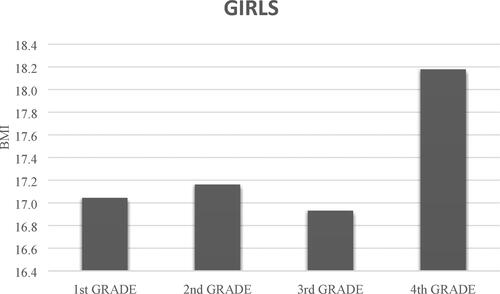
Table 4. Body mass index (BMI) representation for 1st to 4th grade girls.
By comparing the boys’ and girls’ results it can be concluded that only 1st grade boys have a desirable body mass index (BMI) value, while boys attending other grades show elevated levels of the body mass index (BMI) value. A significant increase in the average values (BMI) among fourth grade boys was noticed. The situation is reverse for girls: only 1st grade girls have an elevated body mass index, while girls attending other grades have a desirable body mass index value. As with boys, girls also show a major increase in average values (BMI) in the fourth grade.
The research conducted by Jureša et al. (Citation2012) on a representative sample of 960 male and female first-grade pupils (averagely 7.5 years old) from 40 Croatian primary schools showed that more than a fifth of the participants had a problem with overweight, or more precisely, there were 13.8% of boys and 12.6% of girls in the group of those overweight, whereas 8.3% of boys and 6.9% of girls were in the obese group. Another longitudinal research (Kunješić, Citation2015) recorded even more devastating results among first graders of two primary schools in Zagreb. There were 15% of boys and 24% of girls with overweight, while 13% of boys and 5% of girls were obese. Until the end of the fourth grade the percentage of overweight and obese boys remained steady around 28% to 29%. Regarding girls, the percentage of overweight and obese pupils decreased, and it especially became conspicuous in the fourth grade when it decreased by 7% among the obese girls.
The results obtained in this work are similar to the studies formerly conducted in Croatia among primary-grade pupils in Zagreb (Kunješić Sušilović et al., Citation2016). By comparing the average body mass index (BMI) trends of the participants in the present research to the research conducted by the aforementioned authors, higher average values can be noticed in our research pupils, they are especially prominent in the fourth grade, and the girls’ results are equal in both research studies during the observed period. Furthermore, the results obtained by the polynomial regression analysis showed differences in the participants’ nutritional level assessed by the body mass index and the percentage of body fat, as well as the significant impact of time on the indicators of the nutritional status for both sexes. The authors have concluded, according to the results obtained in this paper, that a worse nutritional state was more commonly registered among boys than girls, which was not the case in the research conducted a few years ago when girls had a poorer nutritional state than boys (Kunješić Sušilović et al., Citation2016). A linear growth of the body mass index value among children and adolescents can be seen in other foreign studies (Freedman et al., Citation2012). If this research results and the results of the aforementioned Croatian studies are compared to research results in other parts of Europe, it can be deduced that our children have higher values of the body mass index in all observed school grades than their peers from Sweden and Estonia (Ruiz et al., Citation2006) and Germany (Schaefer et al., Citation1998).
The results analysis explained that 85 boys (69.1%) engage in sports in their free time, which is a good indicator of physical activity. Thirty-eight boys do not practise sports in their free time which is a total of 30.9% of participants ().
leads to the conclusion that 107 examined girls practise sports in their free time which makes 75.4% of participants, while 35 of them, i.e. 24.6% do not practise sports at all.
By comparing results among boys and girls, it can be concluded that most of the children of both sexes practise sports in their free time, i.e. as many as 72.5% of girls and boys do sports in their free time, while 27.5% of girls and boys do not practise any sport. The relatively high percentages of children’s active participation in sport and sport activities in their free time is encouraging, since doing sports is an important factor in the preservation and advancement of health, especially among children and youths. Krželj (Citation2009) thought that the emerging social changes and the parents’ fear for their descendants’ safety resulted in a higher inclusion of children in organised sport clubs at the expense of physical activities in their house yards and open children’s playgrounds, which led sport to change from a non-formal game to a strictly parent-supervised activity. The findings linked to the parents’ perception have revealed that parents feel increasingly more capable of and prone to invest in their children’s development in all areas, especially regarding their participation in various sport activities. The mentioned changes are, according to Wheeler and Green (Citation2014), the consequence of a number of structural and cultural changes which have been occurring in the last 30 years. The authors conclude that the further pace of children’s participation in sports will depend on the transfer of sport culture inside the family.
Boys who engage in sports in their free time usually have training three times a week (41.5%), twice a week (17.9%) and every day (9.8%) (). Neither of the examined boys has trainings once a week. Jureša et al. (as cited in Jurakić & Heimer, Citation2012) conducted a research on 2,869 children and adolescents in Croatia. They used high intensity physical activity four times a week as a criterion in the classification of participants to the category of insufficiently active. The prevalence of insufficient activity in the first grade of primary school was 71.7% among girls and 54% among boys.
The average boys’ training lasts 60 minutes (37.4%), followed by 90-minute trainings (15.4%). Trainings of the duration of 75 and 120 minutes were present among 3.3% of boys, while 45 and 80-minute trainings were the least represented among boys (0.8%) ().
Table 5. Training duration in minutes among boys.
Girls averagely exercise twice a week (35.2%), followed by those who exercise three times a week (24.6%) (). There were 14.8% of girls who exercised every day, while only one girl had her training once a week.
Girls who practice sports in their free time usually have 75 (31.7%) and 80 (27.5%) minute trainings (). They are followed by 90-minute trainings (2.8%), while only one girl had training lasting 45, 60 or 120 minutes (0.7%).
Table 6. Training duration in minutes among girls.
The analysis of this variable indicates that there is a difference among the frequency and training duration between boys and girls. Boys most commonly exercise three times a week, while girls exercise twice a week. The average boys’ training lasts 60 minutes. On the other hand, the average girls’ training lasts 75 minutes.
The obtained data show that boys usually spend 2 to 3 hours a day outdoors (76.4%) (). Less than an hour outdoors is spent by 19.5% of boys, while 4 to 5 hours a day was evidenced for 4.1% of boys.
By the analysis of this variable it can be concluded that girls mostly spend 2 to 3 hours a day outdoors (66.2%) (). Less than an hour a day outdoors is spent by 28.9% of girls, while 4.9% of them spend 4 to 5 hours a day outdoors. The comparison of girls’ and boys’ results leads to the fact that both girls and boys spend 2 to 3 hours a day outdoors. The notion of time spent outdoors also includes the time spent in the park or on the playground.
The univariate analysis of variance was used to determine the differences in the analysed variables for girls and boys. The results are presented in .
Table 7. Difference in the analysed variables between girls and boys.
The univariate analysis of variance has determined that there is a statistically significant difference between boys and girls of a younger school age only in the variable body height, which means that girls are significantly taller than boys in terms of statistics. The other analysed variables have shown that there are no statistically significant differences between boys and girls attending lower primary school grades in nine primary schools of Pula.
The obtained significant difference in body height in favour of girls is completely opposite to the longitudinal research conducted by Kunješić (Citation2015) conducted in two primary schools in Zagreb (107 participants). Namely, the research which aimed to investigate the level of physical activity and the estimation of the nutritional state established a significant difference between boys’ and girls’ body height. Moreover, the results showed also the following: during the entire primary education boys are somewhat taller than girls, the physical activity stagnates over the years, there is no significant difference in physical activity among girls and boys, boys have significantly higher results in the forearm circumference, and over the years boys spend more time doing moderate-intensity activities, whereas girls do low-intensity activities more.
Conclusion
The results obtained on a sample of 265 girls (53.6%) and boys (46.4%) of a younger school age show that boys are averagely 136.5 cm tall and weight 33.7 kg. Girls are averagely 139.2 cm tall and weigh 34.1 kg. The analysis of the body mass index (BMI) in single grades indicates that boys and girls have a normal nutrition status in the first and third grade, while higher values of the body mass index (BMI) were noticed for second and fourth grade girls and boys.
Results show that most girls and boys of a younger school age practise sports in their free time, i.e. there are 72.5% of them who do, but 27.5% of them who do not practise sports at all. Boys usually train three times a week, girls train twice a week. The average boys’ training lasts 60 minutes, while for girls it lasts 75 minutes. Moreover, it can be concluded that both girls and boys spend 2 to 3 hours a day outdoors (70.9%). This is followed by those who spend time outdoors less than an hour a day (24.5%), and 4 to 5 hours a day (4.5%).
The univariate analysis of variance determined differences between boys and girls, while the obtained results show that there is no statistically significant difference between boys and girls of a younger school age regarding the analysed variables, except for the variable body height, which means that girls are significantly taller than boys in terms of statistics. Namely, there are differences in the level of nutrition between boys and girls, where first grade boys are of a normal nutritional status (BMI = 16), whereas boys from other grades have a slightly elevated body mass index. The situation is reverse among girls. First grade girls are the only ones to have an elevated body mass index (BMI = 17), whereas girls from other grades have a desirable body mass index. Both among boys and among girls the physical activity is adequate, but differs in the duration and frequency of the training. Boys usually train three times a week with an average training of 60 minutes, whereas girls train twice a week for 75 minutes.
Children’s nutrition is a current problem area regarding the fact that contemporary research indicates the increasingly wide occurrence of obesity in the population of children and young people where an inadequate diet and insufficient physical activity are seen as the main causal factors. The obtained results show that participants of this research mostly have a normal nutritional status, practice sports in their free time and spend enough time outdoors being physically active. In order to diminish the trend of increasing body mass index, a continuous cooperation of parents, teachers and competent school doctors is important, so that if there is a possibility to classify excessive weight or obesity among pupils, adequate approaches to solving the problem could be applied. Everyday educations surely contribute to the awareness about this problem and prevention. Schools should adapt to it by offering pupils quality and nutritious meals, as well as sufficient physical activity on a daily basis, both as part of their compulsory subjects, and extracurricular sports activities adequate to each child.
Disclosure statement
No potential conflict of interest was reported by the authors.
References
- Caspersen, C. J., Powell, K. E., & Christenson, G. M. (1985). Physical activity, exercise, and physical fitness: Definitions and distinctions for health-related research. Public Health Reports (Washington, D.C.: 1974), 100(2), 126–131.
- Chen, L. J., Fox, K. R., Haase, A., & Wang, J. M. (2006). Obesity, fitness and health in Taiwanese children and adolescents. European Journal of Clinical Nutrition, 60(12), 1367–1375. https://doi.org/10.1038/sj.ejcn.1602466
- Cole, T. J., Bellizzi, M. C., Flegal, K. M., & Dietz, W. H. (2000). Establishing a standard definition for child overweight and obesity worldwide: International survey. BMJ (Clinical Research Ed.), 320(7244), 1240–1243. https://doi.org/10.1136/bmj.320.7244.1240
- De Onis, M., Onyango, A. W., Borghi, E., Siyam, A., Nishida, C., & Siekmann, J. (2007). Development of a WHO growth reference for school-aged children and adolescents. Bulletin of the World Health Organization, 85(9), 660–667. https://doi.org/10.2471/blt.07.043497
- Erdeljac, M., Rakovac, M., & Petrić, V. (2018). Trend of body mass index movement of primary school students over a 15 - year period. Odgojno-Obrazovne Teme, 1(1–2), 9–22.
- Freedman, D. S., Goodman, A., Contreras, O. A., DasMahapatra, P., Srinivasan, S. R., & Berenson, G. S. (2012). Secular trends in BMI and blood pressure among children and adolescents: The Bogalusa Heart Study. Pediatrics, 130(1), e159–e166. https://doi.org/10.1542/peds.2011-3302
- Inchley, J., Currie, D., Young, T., Samdal, O., Torsheim, T., Augustson, L., Mathison, F., Aleman-Diaz, A., Molcho, M., Weber, M. & Barnekow, V. (2016). Growing up unequal: Gender and socioeconomic differences in young people′s health and well-being. Health behavior in school-age children (HBSC) study: International report from 2013/2014 survey. WHO Regional Office for Europe.
- Jurakić, D., & Heimer, S. (2012). Prevalencija nedovoljne tjelesne aktivnosti u Hrvatskoj i u svijetu: pregled istraživanja. Arhiv za Higijenu Rada i Toksikologiju, 63(Supplement 3), 3–12.
- Jureša, V., Musil, V., Majer, M., Ivanković, D., & Petrović, D. (2012). Behavioral pattern of overweight and obese school children. Collegium Antropologicum, 36 Suppl 1(1), 139–146. https://doi.org/10.5671/ca.2012361s.139
- Kopelman, P. (2007). Health risks associated with overweight and obesity. Obesity Reviews: An Official Journal of the International Association for the Study of Obesity, 8Suppl 1, 13–17. https://doi.org/10.1111/j.1467-789X.2007.00311.x
- Krželj, V. (2009). Dijete i sport. In N. Aberle (Ed.), Sekundarna prevencija u pedijatriji (pp. 61–69). Slavonski Brod.
- Kunješić, M. (2015). Dinamika pokazatelja stanja uhranjenosti i tjelesne aktivnosti učenica i učenika u primarnoj edukaciji (Unpublished doctoral dissertation). Kineziološki fakultet Sveučilišta u Zagrebu.
- Kunješić Sušilović, M., Prskalo, I., & Mišigoj-Duraković, M. (2016). Dinamika pokazatelja stanja uhranjenosti u osnovnoškolaca. Paediatria Croatica, 60(4), 140–145. https://doi.org/10.13112/PC.2017.21
- Lopes, V. P., Malina, R. M., Maia, J., & Rodrigues, L. P. (2018). Body mass index and motor coordination: Non-linear relationships in children 6-10 years. Child: Care, Health and Development, 44(3), 443–451. https://doi.org/10.1111/cch.12557
- Luciano, A., Piccoli, A., Bonetti, P., Romano, R., Bolognani, M., Castellarin, A., & Zoppi, G. (2001). BMI centile as an indicator of degree of obesity in childhood. La Pediatria Medica e Chirurgica: Medical and Surgical Pediatrics, 23(3–4), 183–185.
- Malina, R. M., Peña Reyes, M. E., Tan, S. K., & Little, B. B. (2011). Physical fitness of normal, stunted and overweight children 6–13 years in Oaxaca, Mexico. European Journal of Clinical Nutrition, 65(7), 826–834. https://doi.org/10.1038/ejcn.2011.44
- Mišigoj-Duraković, M. (2008). Kinantropologija: biološki aspekti tjelesnog vježbanja. Zagreb: Kineziološki fakultet Sveučilišta u Zagrebu.
- Mišigoj-Duraković, M., & Matković, B. (2007). Biološke i funkcionalne osobitosti dječje i adolescentne dobi i sportski trening. In I. Jukić (Ed.), Zbornik 5.godišnje međunarodne konferencije Kondicijska priprema sportaša: kondicijska priprema djece i mladih (pp. 39–45). Kineziološki fakultet Sveučilišta u Zagrebu i Udruga kondicijskih trenera Hrvatske.
- Mišigoj-Duraković, M., Sorić, M., & Duraković, Z. (2011). Zdravstvene koristi tjelesne aktivnosti i vježbanja kod djece i adolescenata. In S. Heimer (Ed.), Tjelesna aktivnost i zdravlje - Uloga tjelesne aktivnosti u prevenciji i liječenju prekomjerne težine i pretilosti (pp. 19–23). Kineziološki fakultet Sveučilišta u Zagrebu.
- Ruiz, J. R., Rizzo, N. S., Hurtig-Wennlöf, A., Ortega, F. B., W Àrnberg, J., & Sjöström, M. (2006). Relations of total physical activity and intensity to fitness and fatness in children: the European Youth Heart Study. The American Journal of Clinical Nutrition, 84(2), 299–303. https://doi.org/10.1093/ajcn/84.1.299
- Schaefer, F., Georgi, M., Wühl, E., & Schärer, G. (1998). Body mass index and percentage fat mass in healthy German schoolchildren and adolescents. International Journal of Obesity and Related Metabolic Disorders: Journal of the International Association for the Study of Obesity, 22(5), 461–469. https://doi.org/10.1038/sj.ijo.0800608
- Wang, Y., & Lobstein, T. (2006). Worldwide trends in childhood overweight and obesity. International Journal of Pediatric Obesity: IJPO: An Official Journal of the International Association for the Study of Obesity, 1(1), 11–25. https://doi.org/10.1080/17477160600586747
- Wheeler, S., & Green, K. (2014). Parenting in relation to children’s sports participation: Generational changes and potential implications. Leisure Studies, 33(3), 267–284. https://doi.org/10.1080/02614367.2012.707227
- World Health Organization. (2010). Global recommendations on physical activity for health. Retrieved February 10, 2021, from http://apps.who.int/iris/bitstream/10665/44399/1/9789241599979_eng.pdf
- World Health Organization [WHO]. (2018). Global action plan on physical activity 2018–2030: More active people for a healthier world. World Health Organization. Retrieved February 10, 2021, from https://apps.who.int/iris/bitstream/handle/10665/272722/9789241514187-eng.pdf?ua=1


